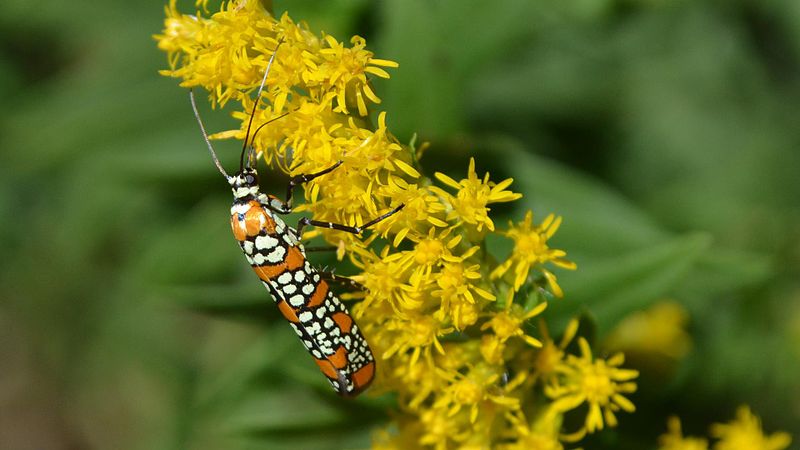Introduction
Ailanthus webworm is an ermine moth commonly found throughout the United States. The insect originated in South Florida and the American tropics, where it infested two plants: paradise tree (Simarouba glauca) and Simarouba amara. It has since adapted to a new host plant called tree of heaven. Formerly known under the scientific name Atteva punctella, the insect is now referred to as Atteva aurea. Ailanthus webworm is a member of the bagworm moth family. This refers to the cottony bags that the larvae spin. It is most recognized for its distinct coloration, and unique body. When stationary, the insect resembles a true bug or beetle. When in flight, it appears similar to a wasp. Ailanthus webworm is considered a minor pest in nurseries, and landscape settings, where it causes minor defoliation on host plants.
Distribution & Habitat
Ailanthus webworm is found across the continental United States, ranging from New York to Florida, and west to Nebraska and Texas. It may occasionally be observed in eastern Canada, where its northern limit extends into eastern Ontario and southwestern Quebec.
Hosts
Ailanthus webworm constructs webs on the leaves of tree of heaven (Ailanthus altissima), an invasive species that has been widely introduced and naturalized from China.
Description
Ailanthus webworm is most notable during its larval and adult stages. The larvae range from light brown to black in color. Their heads are bright red, and speckled with white spots. Each larva has a wide, light greenish-brown stripe that extends along the back. Several thin, alternating white and olive-green stripes can be observed along each side of the abdomen. Adult moths are long and thin. They have two bulbous eyes, and a set of antennae that protrude out from the head. Six black legs extend out from the abdomen, with white bands denoting each segment. The front set of legs often exhibit a purple and green sheen. The adult’s forewings feature alternating orange bands, and white spots enclosed in black markings. The hindwings are colored smoky gray. Adults tuck and roll their wings close to their bodies, as opposed to spreading them out or laying them flat against themselves.
Life Cycle
The life cycle of Ailanthus webworm progresses quickly. Some insects transition to adults within four weeks. This enables Ailanthus webworm to produce many generations each summer, with eggs often laid on the webs of other larvae. As the webs overlap, they become a larger communal web, comprising multiple generations in various stages of their development. The larvae appear from mid to late spring. They produce nests on the host plant by enfolding two or more leaflets around a network of loose webbing. Within the webbing, the larvae feed on leaves, flowers, seeds, and bark. Eventually, the larvae settle down to pupate. They attach the cocoon to a tree or shrub branch, and begin to pupate. Adults emerge from late spring to late fall. They measure ¾ of an inch to 1 ½ inches in length. Adults are considered good pollinators. They are often seen visiting many species of flowers during the daytime. Adults are diurnal. Mating occurs in the morning. During the evening, females lay their eggs on the larval webbing. Each web may contain an abundance of individual eggs. Adults die shortly thereafter. Eggs overwinter and hatch in spring.
Effects on Trees
Ailanthus webworm is a minor defoliator of host plants. While this may temporarily reduce the ornamental value of the host, any consumed foliage is usually replenished within a single growing season.
Management
Ailanthus webworm is considered a minor nuisance. It does not cause extensive damage to host trees. As such, management of the insect is not required.
Photo courtesy of Andy Reago and Chrissy McClarren/CC-by-A2.0


